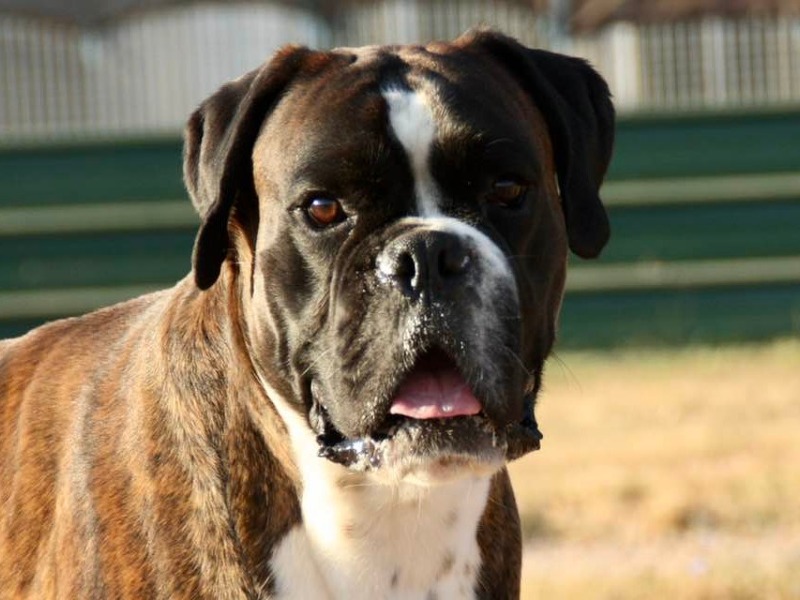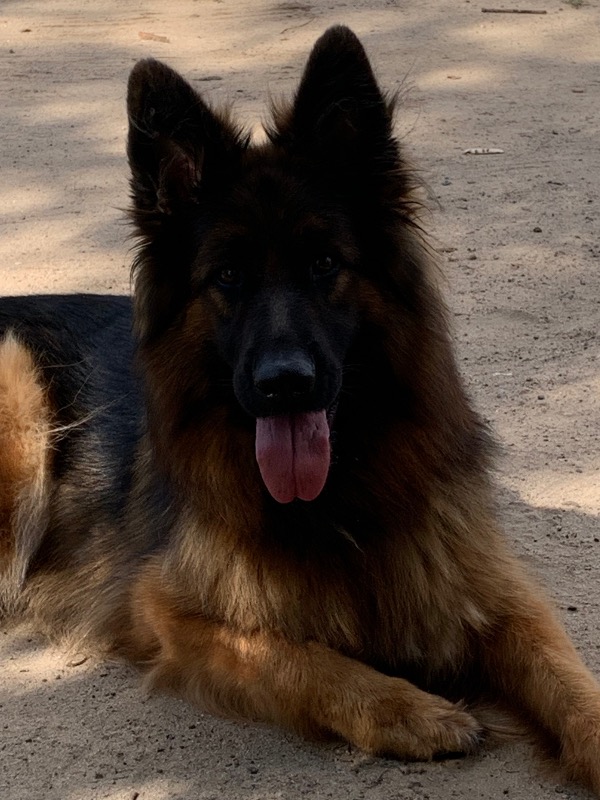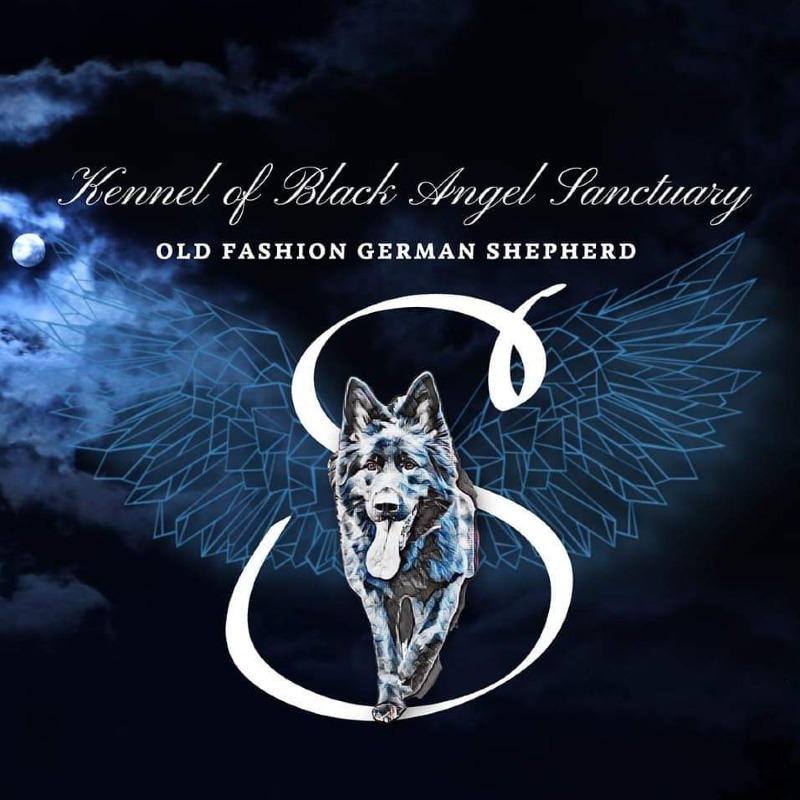German shepherd
Welcome to our page dedicated to the breed of dog german shepherd!
Here, you will find all the useful information about german shepherd. This descriptive profile will allow you to discover the aspects of this breed. You can notably consult information about the average price, monthly and annual upkeep expenses, their health, name ideas, as well as their official recognition by competent authorities.
Explore this page to discover everything you need to know.
Overall description of the breed
Of Germanic origin as its name indicates, the breed was created by Colonel Max Frederic Emile Von Stephanitz at the end of the 19th Century. The aim of creating this breed was to create a dog that was useful in work, with great intelligence and physically robust, useful for guarding flocks and people.
Versatile, it is regularly used as a working dog in specific fields such as rescuing people in difficulty, civil security or in the army, particularly during the First and Second World Wars to assist wounded soldiers. Nowadays, the German Shepherd Dog's exceptional aptitudes have enabled it to be used in prestigious police services such as elite or intervention groups, anti-smuggling or mountain rescues.
The German Shepherd was officially recognised by the International Cynological Federation on 1 January 1955, the latest update of the official standard in force was published on 11 August 2010.
The German Shepherd is of medium size, its body shape is rather elongated, but remains in harmony with its overall anatomy, its shoulders are slightly higher than its topline, its muscular hindquarters give it a lot of power, especially when it exerts a strong push on its hind legs. The German Shepherd is an elegant, athletic and agile dog, with lean bones and an overall solid build.
Its head is wedge-shaped, well proportioned to the size (its length is about 40% of the height at the withers) with a strong skull, but not excessive. The muzzle is long and strong, with a shallow stop, and the almond-shaped eyes should be as dark as possible. The German Shepherd has several qualities of coat, the single short, double or long double coat, the colours or shades admitted by the breed standard are black, with red-brown, brown or yellow markings up to light grey or black and grey unicolour, the grey being charcoal, black mantle and mask, all associated with a dense light grey undercoat; white is not admitted.
His character has been part of his immense popular success, he is a playful, willing and versatile dog with extraordinary assimilation skills. Always seeking reward from its owners, it is a faithful companion and loyal to its social group, especially its master for whom it has unlimited admiration.
The German Shepherd's main objective is to please his owner, he needs to be useful to feel totally fulfilled. Benevolent and affectionate, they will look after the safety of their home, enjoying the company of young children with whom they will be particularly protective.
Patient and fairly calm, they will still need to exercise intensely every day, as they are active pets and curious about everything. Its jovial temperament can sometimes hide a dominating instinct towards its fellow dogs, which is an important point of education to be supervised from an early age. Extremely attached to his family, he does not tolerate solitude and can feel abandoned if you do not devote enough time to him.
In conclusion, the German Shepherd is a reliable companion, with exemplary physical and mental aptitudes, he combines all the qualities of the ideal dog! It is for all these reasons that it has very quickly become the most popular and widespread breed in the world.
Adult: The German Shepherd Dog will weigh approximately 66 to 88 lbs for males and 48 to 70 lbs for females, its height at the withers will be approximately 23" to 25" for males and 21" to 23" for females.
Awareness of acquiring an animal
Each animal is a sensitive being, deserving love, attention and care.
When you choose to adopt an animal, you take on the responsibility of ensuring its health and well-being throughout its life.
To learn more about animal welfare, we invite you to consult our FAQ by clicking the button below:
Origins
The German Shepherd finds its origins in Germany at the end of the 19th century. It is the result of crossing different breeds of local shepherd dogs in order to create a dog that is intelligent, obedient, and endowed with great physical abilities. Captain Max von Stephanitz is often considered the father of the breed. His goal was to create a versatile working dog, capable of handling various tasks, including guarding and protecting herds. The German Shepherd quickly gained popularity thanks to its exceptional qualities, becoming a sought-after breed not only for pastoral work, but also for various roles such as police, search and rescue dog.
History
The German Shepherd was officially recognized as a breed in 1899, the year the first breed club was founded by Max von Stephanitz. Originally used as a herding dog, World War I saw its role expand to that of a war dog, where its tracking skills, loyalty, and courage were highlighted. After the war, the breed spread around the world, notably in the United States, where it was recognized by the American Kennel Club (AKC) in 1908. Today, the German Shepherd is used in a variety of roles, including police work, security services, assistance to people with disabilities, and much more.
Standard
The breed standard of the German Shepherd, as defined by the Fédération Cynologique Internationale (FCI), requires a dog of medium to large size, well proportioned and muscular. The male measures between 60 and 65 cm at the withers and weighs between 30 and 40 kg, while the female measures between 55 and 60 cm and weighs between 22 and 32 kg. The head should be noble, slightly wedge-shaped, with straight and pointed ears. The eyes are almond-shaped, dark in color, expressing liveliness and intelligence. The tail is bushy and slightly curved. The coat is double, with a dense outer layer and a thick undercoat. Typical colors include black with tan markings, black, and gray.
Physical characteristics
The German Shepherd is a robust dog, strong and muscular. Males measure between 60 and 65 cm at the withers and weigh between 30 and 40 kg. Females, smaller, measure between 55 and 60 cm for a weight ranging from 22 to 32 kg. The coat is dense and double, composed of a weather-resistant outer layer and a thick undercoat. The most common colors are black with tan markings, black, and grey. The German Shepherd has a fluid and energetic gait, with great endurance. The ears are upright, pointed forward, and the eyes, almond-shaped and dark in color, express intelligence and liveliness.
Character
The German Shepherd is known for its loyal, brave, and intelligent character. It is a dog very attached to its master and family, always ready to protect them. It is also very adaptable and can excel in many roles thanks to its great learning ability and desire to please. The German Shepherd is often used as a working dog because of its discipline and obedience. However, it requires early socialization and firm yet gentle training to avoid overprotectiveness behaviors. It is a faithful, devoted, and protective companion who thrives in a stimulating and loving environment.
Life expectancy
The life expectancy of a German Shepherd is generally between 9 and 13 years. This longevity can vary depending on various factors, such as genetics, nutrition, healthcare, and level of physical activity. Regular check-ups with a veterinarian, a balanced and adapted diet, as well as sufficient physical exercise, help prolong the life of this robust dog. Like with all breeds, some hereditary conditions can affect their health, but early detection and appropriate care can significantly improve the quality and length of a German Shepherd's life.
Exercise and activity needs
The German Shepherd is an extremely active breed that requires regular physical and mental exercise to stay healthy and happy. They need at least two hours of intense exercise per day, including walks, runs, and stimulating games like frisbee or agility. This breed also enjoys activities that involve thinking, such as search games and obedience exercises. A lack of exercise can lead to destructive or anxious behaviors. To maintain their well-being, it is essential to provide them with varied and stimulating exercise opportunities tailored to their high energy level.
Recommended diet
The German Shepherd needs a balanced and nutritious diet to maintain its health and vitality. It is recommended to provide high quality food, adapted to its size, age and level of activity. On average, the monthly cost of feeding a German Shepherd ranges from 50 to 100 euros. It is important to divide its daily ration into two meals to avoid digestive problems. Proteins should make up a significant part of its diet, accompanied by carbohydrates, healthy fats, vitamins and minerals. A consultation with a veterinarian can help determine the most appropriate diet.
Training and obedience
German Shepherd education and training should start at a young age to develop their potential and prevent undesirable behaviors. Thanks to their intelligence and desire to please, these dogs learn quickly and excel in various training exercises. A positive approach, based on reinforcing desired behaviors with rewards, is the most effective. It is also crucial to socialize them early with different people, animals, and environments to avoid mistrust and aggression. Ongoing and consistent training will help them become obedient, balanced, and reliable companions.
Behavior with children
The German Shepherd is generally very protective and affectionate with the children of his family. Thanks to his loyal and benevolent nature, he can be an excellent companion for the youngest. However, due to its large size and energy, it is important to supervise interactions between children and the dog to avoid accidents. Early socialization and proper education are essential to ensure that the dog learns to interact gently and respectfully with children. In return, it is crucial to teach children to respect the dog and to interact with him appropriately.
Compatibility with Other Animals
The German Shepherd can peacefully coexist with other pets if properly socialized from a young age. Due to their protective instinct, they can sometimes be territorial, especially towards unfamiliar animals. Gradually introducing the German Shepherd to other animals, under supervision, helps foster harmonious relationships. It is important to supervise the initial interactions to ensure they go well. With proper socialization and training, the German Shepherd can become a respectful and friendly companion to other animals in the household.
Grooming needs
The German Shepherd has a double coat that requires regular maintenance to keep it clean and healthy. It is recommended to brush its coat at least two to three times a week to remove dead hair and prevent matting. During shedding periods, usually in spring and autumn, daily brushing may be necessary. Baths should only be given when necessary to avoid stripping the natural oils from the skin. Check its ears, eyes, and teeth regularly for any anomalies and trim its nails if they do not wear down naturally.
Health
The German Shepherd is generally a robust breed, but is predisposed to certain hereditary health conditions. Common problems include hip and elbow dysplasia, heart disease, digestive disorders such as bloating, and eye problems. It is essential to choose responsible breeders who test their breeding dogs for these conditions. Regular visits to the veterinarian for health exams, vaccinations, and preventive treatments are essential. Balanced nutrition, regular exercise, and attentive monitoring for any signs of discomfort can help maintain the good health of the German Shepherd.
Average price
The price of a German Shepherd puppy can vary considerably depending on the breeding, lineage, and region. In general, the average cost of a German Shepherd is between 800 and 1,500 euros. For dogs from champion lines or with exceptional qualities, the price can reach or exceed 2,000 euros. It is important to choose reputable breeders who respect the breed standards and ethical breeding practices. The initial price does not include additional fees related to health, equipment, food, and regular care.
Expenses
The monthly expenses for a German Shepherd can vary depending on several factors such as food, veterinary care, toys, accessories, and insurance. On average, these expenses range from 100 to 200 euros per month. Quality food represents a significant part of this budget, with an average cost of 50 to 100 euros per month. Regular visits to the vet, vaccinations, and preventive treatments also add to the costs. In addition, the purchase of durable toys, grooming products, and possibly training classes or sports activities contribute to these expenses.
Name ideas
Choosing a name for your German Shepherd is a pleasant task that often reflects its personality or appearance. Here are some ideas for suitable names: Rex, Max, Luna, Bella, Kaiser, Rocky, Shadow, Zara, Duke, Blitz, Hera, Thor, Stella, Ace, Athena, Zeus, Sasha, Leo, Nova, and Titan. These names are both strong and distinctive, perfectly suited to the noble and dynamic nature of the German Shepherd. Whatever the chosen name, make sure it is easy to pronounce and that your dog responds well to it.
Legislation and regulation
In France, the German Shepherd is not classified among dangerous dogs and is therefore not subject to specific regulations such as those applicable to category 1 and 2 dogs. However, some local regulations may require specific security measures such as keeping the dog on a leash and wearing a muzzle in public places. It is important to check local laws regarding dog ownership and management. In addition, it is recommended to take out liability insurance covering any potential damages caused by your dog. Good socialization and proper training can also help prevent incidents.
Official recognition
The German Shepherd is recognized by many cynological organizations around the world. In France, it is registered with the Société Centrale Canine (SCC). In the United States, the American Kennel Club (AKC) recognizes it, while in the United Kingdom, it is the Kennel Club (KC). In Australia, it is recognized by the Australian National Kennel Council (ANKC). The Fédération Cynologique Internationale (FCI) supervises the recognition of the breed at the international level. These organizations establish the breed standards and organize competitions and events to promote the German Shepherd.
Pedigrees
Pedigrees are documents certifying the origins and lineage of a purebred dog. In France, the Société Centrale Canine (SCC) is responsible for registering German Shepherds and issuing pedigrees. Internationally, several breed clubs are recognized, notably the German Shepherd Dog Club of America (GSDCA) in the United States, the German Shepherd Dog Council of Australia (GSDCA) in Australia, and the British Association for German Shepherd Dogs (BAGSD) in the United Kingdom. These clubs ensure the preservation of breed standards and provide resources for breeders and owners.
Destination and usage
The German Shepherd is a versatile breed used in many fields thanks to its exceptional physical and mental abilities. Initially intended for herding, it is now widely employed as a working dog in police, military, search and rescue. It is also an excellent family pet for active families and a loyal companion for individuals with special needs, such as people with disabilities. Its ability to learn quickly and its obedient nature make it an ideal candidate for various canine sports activities, such as agility, tracking, and obedience.
Prohibitions
The German Shepherd is generally not subject to specific prohibitions, but it is important to respect local regulations regarding dogs. In some regions, rules may apply to all dogs, such as wearing a leash and muzzle in public places. It is also essential to comply with laws on vaccination and sterilization. Sometimes, restrictions may apply to the presence of dogs in certain housing or establishments, so it is advisable to check the specific policies of your place of residence or visit. Proper education and socialization help prevent problems and ensure that the German Shepherd is well accepted wherever it goes.
Breeders of German shepherd
Want to see more breeders of German shepherd?
Check out the page of our directory listing all breeders of German shepherdClassified Ads of German shepherd
Breed clubs of german shepherd
No of german shepherd breed clubs are currently registered on Preeders.
If you would like to highlight your breed club, sign up for free now and be the first to appear on this page.









